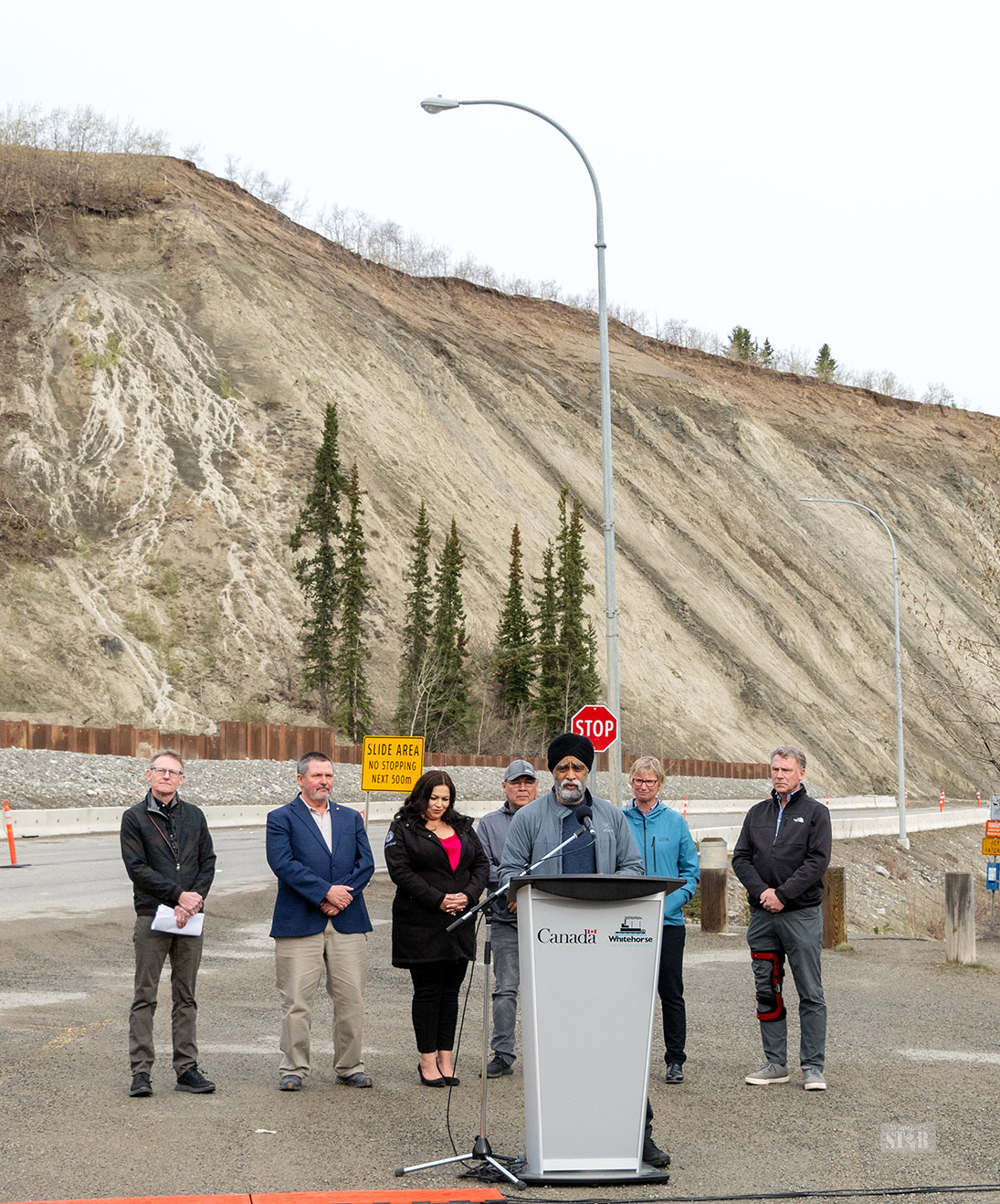Mayor hails ‘ this very significant project’
The city’s clay cliffs instability problems have attracted a landslide of federal funding assistance.
By Whitehorse Star on May 6, 2024
The city’s clay cliffs instability problems have attracted a landslide of federal funding assistance.
To mitigate the effects of groundwater seepage triggering escarpment mudslides, the federal government is investing almost $46 million in
fixing the problem.
The funding was announced this morning in Whitehorse – two days after a minor slide by Robert Service Way (see photo, p. 3).
The money was unveiled by Harjit Sajjan, the minister of Emergency Preparedness and the minister responsible for the Pacific Economic
Development Agency of Canada.
He spoke on behalf of Sean Fraser, the minister of Housing, Infrastructure and Communities. Mayor Laura Cabott also participated in this morning’s announcement.
The planned work will help protect the land beneath the Erik Nielsen Whitehorse International Airport that’s at the top of the escarpment
and Robert Service Way at the base.
“Helping to protect the escarpment from future landslides means residents of Whitehorse and surrounding areas will be safe, be able to
keep access to essential services, use the Millennium Trail safely, and get to where they need to go without delays from road closures,” the government said in a statement.
“To address the reoccurrence of landslides and improve the community’s resilience to the impacts of climate change, Robert Service Way and the Millennium Trail will also be moved further from the base of the Whitehorse escarpment.”
Other components of the project include regrading the slope, supporting revegetation, expanding the débris barrier and implementing anti-erosion measures such as removing rocks and dirt.
“Making adaptation investments now will have major economy-wide benefits later,” the the government said.
“Every dollar of that is invested to adapt and prepare for climate-related landslides along the Whitehorse escarpment will see more than a doubling in financial benefits.
Floods, including landslides, “are the costliest disasters in Yukon,” Sajjan said.
“This stabilization project is a vital and proactive investment in resilient infrastructure and climate adaptation to ensure the safety of
residents and visitors while preserving crucial trade routes from the increasing impacts of climate change.”
Yukon MP Brendan Hanley said vital work “can now be done to realign the main thoroughfare of Robert Service Way and Millennium Trail to avoid landslide disruptions and to fortify the Whitehorse escarpment from further erosion.
“This work will also prevent harmful erosion to the land surrounding the airport. We will be protecting and preserving the unique natural
setting of the Yukon while also ensuring that the area will be safe for people as they access essential services and their daily destinations.”
The source of the money is the Disaster Mitigation and Adaptation Fund.
Since 2018, the federal government has committed more than $3.8 billion to the fund for project across Canada.
“The city is excited to be able to move forward with this very significant project,” Cabott said.
“Robert Service Way is a major transportation route for our city – one of just a couple of ways in and out of downtown Whitehorse – serving our residents with a convenient way to get to school, work and many other important places every day.”
The city applied for federal funding assistance for escarpment remediation work in 2023.
The money means the city “can go ahead with our plan to address the landslides that have impacted this road in recent years (2022 and
2023),” Cabott added.
“I want to thank the Government of Canada for recognizing the importance of this major project and also recognize city staff and
contractors for their proactive work to keep the area safe.
“As we continue to deal with the impacts of climate change, it is important we remain proactive in our efforts.”
Including today’s announcement, more than $2.53 billion has been announced for 95 infrastructure projects that help communities better
prepare for and withstand the potential impacts of natural disasters, prevent infrastructure failures, and help keep Canadians safe,” the
government said.

Be the first to comment